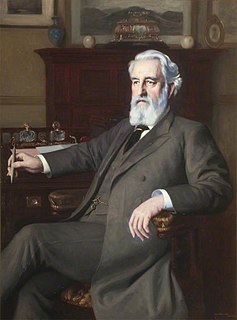| James Forrest | |
|---|---|
| Born | 30 November 1825 Westminster, London, England |
| Died | 2 March 1917 (aged 91) St. Leonard's-on-Sea, East Sussex, England |
| Monuments | James Forrest Medal |
| Known for | Secretary of the Institution of Civil Engineers |
James Forrest (30 November 1825 – 2 March 1917) was Secretary of the Institution of Civil Engineers from 1856 to 1896. [1] Forrest was born in Westminster, London. [1] At the age of 17, in 1842, he became apprenticed to engineers Edward and John Manby before later moving on to work for Thomas Grainger. [1]

The Institution of Civil Engineers (ICE) is an independent professional association for civil engineers and a charitable body in the United Kingdom. Based in London, ICE has over 92,000 members, of whom three quarters are located in the UK, while the rest are located in more than 150 other countries. The ICE aims to support the civil engineering profession by offering professional qualification, promoting education, maintaining professional ethics, and liaising with industry, academia and government. Under its commercial arm, it delivers training, recruitment, publishing and contract services. As a professional body, ICE aims to support and promote professional learning, managing professional ethics and safeguarding the status of engineers, and representing the interests of the profession in dealings with government, etc. It sets standards for membership of the body; works with industry and academia to progress engineering standards and advises on education and training curricula.

Westminster is an area in central London within the City of Westminster, part of the West End, on the north bank of the River Thames. Westminster's concentration of visitor attractions and historic landmarks, one of the highest in London, includes the Palace of Westminster, Buckingham Palace, Westminster Abbey and Westminster Cathedral.

Thomas Grainger FRSE was a Scottish civil engineer and surveyor. He was joint partner with John Miller in the prominent engineering firm of Grainger & Miller.
In 1850 he was contracted to assist Charles Manby catalogue the library of the Institution of Civil Engineers. Forrest edited the library catalogue published in 1851. [1] He was briefly Assistant Secretary of the Royal Society of Arts before returning to the Institution of Civil Engineers in June 1856 as Assistant Secretary. [1] In 1859 he was made Secretary of the Institution of Civil Engineers. [1]

Charles Manby, FRS was Secretary of the Institution of Civil Engineers from November 1839 to 1856, and engineer of the first iron steamer to cross the English Channel. Fluent in French, he installed gas piping into Paris and advised on the construction of the Suez Canal.

The Royal Society for the Encouragement of Arts, Manufactures and Commerce (RSA) is a London-based, British organisation committed to finding practical solutions to social challenges. Founded in 1754 by William Shipley as the Society for the Encouragement of Arts, Manufactures and Commerce, it was granted a Royal Charter in 1847, and the right to use the term Royal in its name by King Edward VII in 1908. The shorter version, The Royal Society of Arts and the related RSA acronym, are used more frequently than the full name.
Forrest lived at 37 St. Michael's Grove in London during his career. [1] He died in 1917 at his home in St. Leonard's-on-Sea. [1]
The James Forrest Medal of the Institution of Civil Engineers was established in his honour upon his retirement in 1896. [1]










